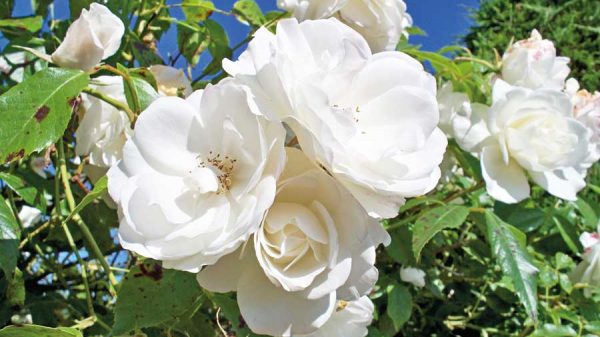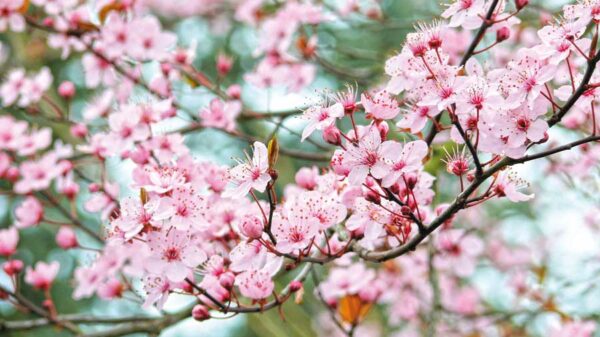June is a month when the freshness of new plant growth starts to reveal summer displays of colour and scent. It’s a time when the garden starts to deliver on its promise of charm and exuberance, but in addition a time when both weed and grass growth is booming. The wet winter and early spring have meant that plant growth has been exceptional and with a little sunshine plants will produce bountiful displays and equally predicted is the promise of bumper fruit crops. In the vegetable garden we have been harvesting early salad leaves and clearing away the remnants of broccoli, kale and winter cabbages, a sign that it is time to sow brassicas for harvesting next spring.
Keeping on top of the weeds seems a never ending task, with every sprinkle of rain another generation of weed seedlings emerge, where do they all come from? Whilst seed can be blown in from neighbouring gardens and green-spaces, its amazing just how much dormant seed is contained within the top few inches of soil. A gardeners rule of thumb is that one year’s seed will produce weeds for the next seven years, a frightening thought, so it’s important to keep on top of removing weeds before they flower so they don’t have chance to seed.
As plants put on growth and especially those grown annually for flower fruit or vegetables it is important to feed them regularly. Plants like tomatoes are very hungry, but when you think each plant has the potential to produce huge crops of fruit there is no way the compost they are growing in will hold enough nutrient for the whole season. I try to establish a routine and find that setting a particular day to a task means we generally keep on top of jobs. ‘Feeding Friday’ is the day we aim to feed all the plants in containers and in the greenhouses, using whatever we have to hand. We make our own feed from Comfrey to Banana skins but there is no doubt that a proprietary general liquid feed from your local nursery or garden centre will provide a more balanced feed and is more convenient to store and use.
‘Dead heading’, or removing faded flowers is very important at this time of year as removing faded flowers encourages plants to produce more blooms, this is true for all our annual bedding plants and shrubs such as roses and herbaceous perennials, and involves simply snipping with secateurs or nipping off using your finger and thumb, it’s a good idea to check if container plants need watering at the same time.
There is considerable discussion about leaving some weeds in your lawn and even refraining from cutting your lawn at all during May, due to the value that this will bring for wildlife and pollinating insects. Whatever your view its important to weigh up the consequences, for example if you let your lawn grow for a month will your mower be able to cut a months growth? or would it be better to designate a small area of your garden for a wildlife area bearing in mind that you may have to tidy it up at least once every year. There are many gardeners who like the look of a well manicured lawn reminiscent of a smooth flat golf green or a neatly mown cricket field, where weeds are banished and the lawn is fed at least twice every year and weeds are not allowed at any price, but unless this is your passion then a weed free lawn is not necessary and during dry weather, close mowing can stress the lawn causing dry brown patches. We prefer to call the green stuff between our beds and borders just the mown areas, which contain many species of plants that don’t mind mowing and don’t become a nuisance.

It’s nice to see a few daisies, creeping thyme, ajuga, common speedwell, clover and the like, they all survive quite happily providing you don’t mow too short, setting your mower to leave the grass about 25mm (1”) will mean that during dry spells it will generally stay green, and indeed many of these plants will provide a tapestry of green during even the driest period, with some flowering and providing a food source for insects.

With fruit such as apples, pears, plums and cherries, there is a term used called the ‘June Drop’, it is a natural process that many fruit trees adopt where they have too much fruit on, and so they abort a proportion. You will often see some of the young fruit remaining small and turning yellow. It’s important at this stage not to be tempted to thin the fruit, and wait until next month to remove any misshapen, deformed or overcrowded fruit.
Happy Gardening, Martin.
Next month, cutting back perennials, trim hedges and look through bulb catalogues.
Top Tip –
Keeping Marigolds In Your Greenhouse
We rarely have to spray for pests in the greenhouse, and prefer to choose plants that help deter them where possible. One common summer pest is the ‘white fly’ clouds of tiny white flies whos offspring feed on the sap of greenhouse plants. Brushing past can release a cloud of white- flies, which in themselves are harmless to humans but can severely affect greenhouse crops.

Hygiene is the first step, and in late autumn when all the greenhouse crops have finished, I take all the remaining plants out and wash the whole greenhouse, inside and out with garden disinfectant, I find the plant based (citrus) greenhouse disinfectants quite effective and the bonus is they are not a problem for wildlife.
During the summer months it is difficult to use disinfectants especially if your greenhouse is full of plants, so I have two types of plant that I keep in the greenhouse along with rows of tomatoes, a cucumber or two and a melon plant. Firstly a perennial that is quite hardy and great at keeping on top of flies the sarracenia. We have a nursery near to us called ‘Wack’s Wicked’ plants specialising in carniverous plants, such as sarracenia, sundew, and venus fly traps. We have a small collection of sarracenia’s which are hardy and can be kept in an unheated greenhouse throughout winter, some stay in the greenhouse all year but they are hardy enough to keep outside and are great to grow in a container on your patio, the bonus is that they are great at controlling flies if you like to sit out in the evening.
The other plant is French marigolds, which are brilliant at keeping ‘white fly’ at bay, so I either sow a few or pick up a pack of six from the local nursery or garden centre, pot them up individually into 2 litre pots and arrange them between the tomato plants, water the same as tomatoes and give them a liquid feed every three weeks, you can use the same as for your tomatoes.







